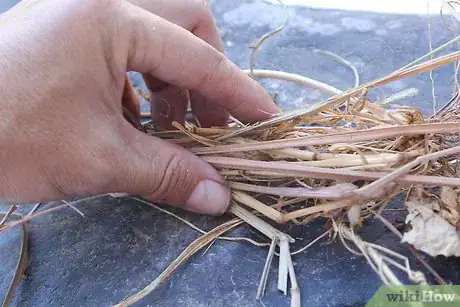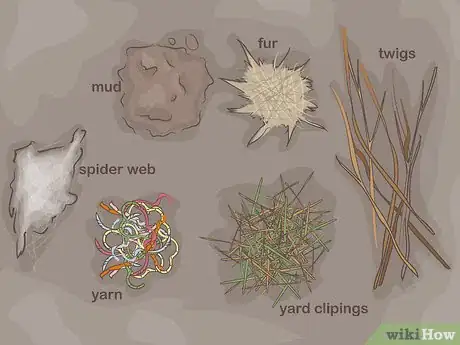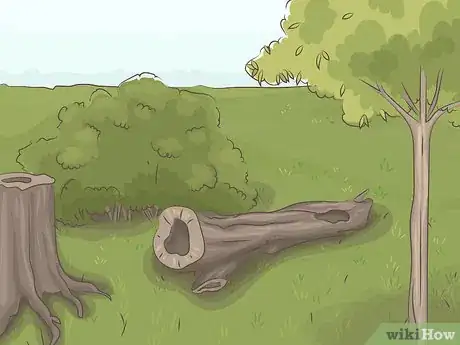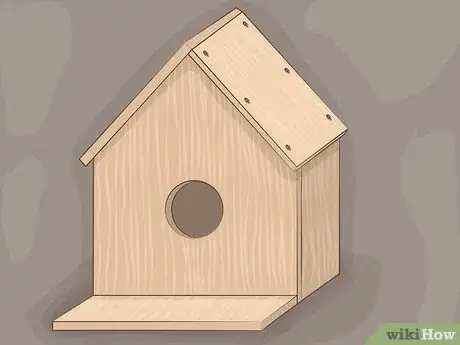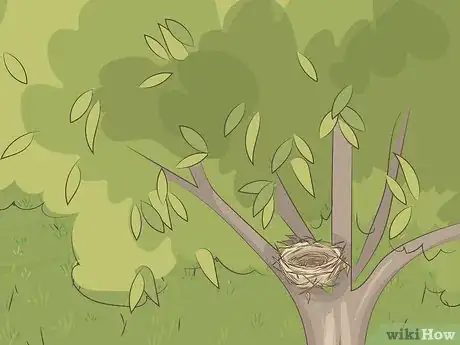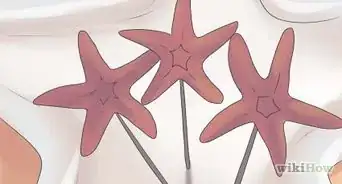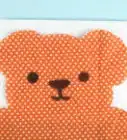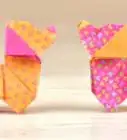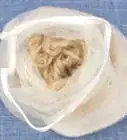wikiHow is a “wiki,” similar to Wikipedia, which means that many of our articles are co-written by multiple authors. To create this article, 23 people, some anonymous, worked to edit and improve it over time.
This article has been viewed 294,219 times.
Learn more...
A bird's nest makes a wonderful mantelpiece decoration, and can make use of almost anything you find along a nature hike, or in your front yard. Wild birds usually prefer to make their own nests, but you can lure many species to your yard by leaving the right materials outside, or building a nesting box.
Steps
Building a Decorative Nest
-
1Find long, flexible plant stems. These will form the main shape of the nest, and are much easier to work with than hard, short twigs. You can use straw, long grass, vines, willow fronds, bendy reeds, or seagrass found outdoors or at a garden supply store. Raffia is another good option, obtainable from a craft supply store.[1]
- If Mexican feather grass grows in your area, grab a clump of it and pull your hand upward to remove a handful of hairy seeds clinging together. Once you have enough seeds, clump them into a ball and make a nest shape by sticking your thumb into it.
-
2Bend the stems into a loop. Grab a thick handful of the stems, and bend them into a U shape, adding more stems if necessary to form a full circle. Tie it in place using a piece of string or florist wire. If the plant stems have many little leaves, or if they're wiry and dry, you can even weave them together without using any attachment.
- If tying the nest together is too hard, you can clip them temporarily in place while waiting for glue to dry.[2] Don't use glue if you plan to keep the nest outdoors.
- If your fresh-cut plants won't stay in position, try hanging up the bundle in a windy area to dry for 24 hours. Some plant stems are easier to bend when fresh, but grasses and straw benefit from drying.
Advertisement -
3Shape the rest of the nest. Grab a second, smaller handful of stems and shape it into a smaller loop. Wedge this inside the larger loop and push it downward to form the base of the loop. Depending on how well the stems fit together and how sturdy you want the nest to be, you may need to use a thread or glue to fasten the two loops together.
-
4Decorate with scavenged materials. Real birds sometimes spend days collecting bits and pieces to build a nest. Hopefully you're a little faster, but you can still have fun gathering objects from nature or your craft boxes. Here are some ideas to get you started:
- If you plan to leave the nest outside, only use materials found outdoors, and nothing that could hurt an animal.
- Feathers and pieces of eggshell fit the theme. Be aware that collecting most wild feathers is illegal in the United States, but they are mostly harmless from a disease perspective.[3] [4] [5]
- Look for twigs, leaves, bark, and moss in interesting shapes and colors.
- If the nest is for indoor decoration, you can use bits of string, colored paper shreds, and confetti.
-
5Place eggs inside (optional). Finish your art project by placing eggs or fake eggs inside the nest. You can quickly add marbles or colorful pebbles, or hollow out real eggs, decorate them, or even carve them if you have the right tools.
Attracting Wild Birds to Nearby Nests
-
1Look up the nesting habits of local birds. Find a local wildlife guide at a library or bookstore, or search online for information on local birds. Choose one or more species you want to attract, and look up their nesting habits to discover what shape and style of nest will be most effective.
-
2Leave nesting material in your yard. This is an easy way to attract birds, and might be worth it even if you end up building a full nest as well. If you managed to find specific nesting information, you'll know what materials to leave, but you can't go wrong with a few items from the following list, left in visible locations:
- Rigid twigs (for platform nest species) and flexible ones (for cup nest species)
- Yard clippings such as dry grass and straw, bits of bark and moss, dead leaves, etc.
- Human or animal hair or fur (no longer than 6 inches / 15 centimeters)
- Yarn or string
- Mud, spiderwebs, and/or caterpillar cocoons to help birds bind nesting materials together
- Never leave out materials that have come into contact with harsh chemicals, including dye, pesticides, or anti-flea treatments. Dryer lint and clothing rags are not recommended.
-
3Provide a variety of plants. If you want to attract birds that make nests in existing holes, leave dead tree stumps and fallen logs in the yard. Living trees and bushes will attract more visible nests from other species, especially if the plants are native to your area. For best results, plant a "staircase" of grass or moss, flowering perennials, shrubs, and trees.
-
4Build a nesting box. If there aren't obvious crevices or hollows in your yard, building a nesting box or birdhouse is a simple carpentry project. Make sure the birdhouse is constructed to match the size of the birds you want to attract, or the size of the birds you see flying near your home.
- For a higher chance of success, follow birdhouse building instructions specific to common North American species.
- Clean out the birdhouse regularly whenever birds are not nesting.
-
5Make a bird's nest. Many birds prefer to make their own nest rather than move in to a ready-made one. Lining natural hollows with the nesting materials listed above may give a bird an attractive head start. If you want to make a different type of nest, such as a cup or platform nest, it's best to follow the specific habits of the bird species you want to attract. Each species tends to prefer certain materials.
- Placement of the nest is also important. Many bird species hide their nest amidst thick branches, but some prefer more open branches, bushes, or open patches of ground. Look for more information on NestWatch, through online searches, or in a local bird nest identification guide.
Community Q&A
-
QuestionWhere do you get all the supplies?
 Community AnswerYou can find the necessary items on the ground in a park or wooded area, perhaps even your back yard!
Community AnswerYou can find the necessary items on the ground in a park or wooded area, perhaps even your back yard! -
QuestionHow do I make the nest big?
 Community AnswerYou can use longer sticks that are pliable enough to bend. Just make sure not to break them.
Community AnswerYou can use longer sticks that are pliable enough to bend. Just make sure not to break them. -
QuestionWhat if I live in the city?
 Community AnswerIf you live in the city and want to attract birds, put up bird feeders. Birds love cracked corn, nyjer seeds, black oil seeds, fruits, and millet. Just make sure to take measures to keep the squirrels out.
Community AnswerIf you live in the city and want to attract birds, put up bird feeders. Birds love cracked corn, nyjer seeds, black oil seeds, fruits, and millet. Just make sure to take measures to keep the squirrels out.
Things You'll Need
Decorative nests:
- Any long, flexible bundle of stems, grass, or straw
- String, florist's wire, or glue (recommended unless stems interweave easily)
- Moss, bark, twigs, or other decorative materials
- Eggs and egg-blowing materials (optional)
- Marbles, pebbles, or other "fake eggs" (optional)
Wild bird nests:
- Any yard clippings, especially twigs and grasses
- String or yarn
- Mud, spiderwebs, or caterpillar cocoons
- Human hair or animal fur
- Small amount of lumber and nails (to build a nesting box, if hollow logs not available)
Warnings
- If a wild bird moves in to your nest, don't disturb it or the surrounding area. Watch the nest from somewhere the bird can't see you, or you may scare the bird away or attract predators to the nest.⧼thumbs_response⧽
References
- ↑ http://www.katescreativespace.com/2013/03/01/nesting/
- ↑ http://www.katescreativespace.com/2013/03/01/nesting/
- ↑ http://www.adirondackalmanack.com/2010/03/ellen-rathbone-on-collecting-bird-feathers.html
- ↑ http://www.birds.cornell.edu/birdflu/what-you-should-know/q-a/is-it-safe-to-pick-up-feathers
- ↑ http://www.sciencebuddies.org/blog/2012/01/find-a-feather-pick-it-up.php
- ↑ http://nestwatch.org/
About This Article
To make a bird nest, start by collecting long, flexible plant stems like straw, vines, long grass, or bendy reeds. Then, take a handful of stems, bend them into a loop, and secure the ends together with a piece of string or florist wire. Next, shape the nest by taking a smaller handful of stems and forming a smaller loop to fit inside the larger one. Use your hands to carefully press the small loop into the bottom of the nest. Finally, decorate the nest with items like twigs or feathers for the bird’s eggs to rest on. To learn how to attract wild birds to nests with nesting materials like hair and yarn, keep reading!
